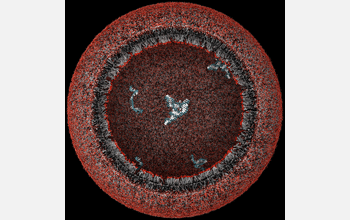Multimedia Gallery
Model Protocell (Image 2)
A three-dimensional view of a model protocell (a primitive cell) approximately 100 nanometers in diameter. The protocell's fatty acid membrane allows nutrients and DNA building blocks to enter the cell and participate in non-enzymatic copying of the cell's DNA. The newly formed strands of DNA remain in the protocell.
There are no physical records of what the first primitive cells on Earth looked like, or how they grew and divided. The primitive cell, modeled by a team of researchers at Harvard University, is capable of building, copying and containing DNA, and will give scientists the opportunity to study how the Earth's earliest cells may have interacted with their environment approximately 3.5 billion years ago.
The research was supported by a grant from the National Science Foundation's Division of Chemistry (CHE 0434507). To learn more about the discovery, see the NSF press release "A New Way to Think About Earth's First Cells." (Date of Image: 2008) [Image 2 of 2 related images. Back to Image 1.]
Credit: Janet Iwasa (Distributed under Creative Commons license Attribution-ShareAlike 3.0 Unported)
Special Restrictions: Distributed under Creative Commons license Attribution-ShareAlike 3.0 Unported.
Images and other media in the National Science Foundation Multimedia Gallery are available for use in print and electronic material by NSF employees, members of the media, university staff, teachers and the general public. All media in the gallery are intended for personal, educational and nonprofit/non-commercial use only.
Images credited to the National Science Foundation, a federal agency, are in the public domain. The images were created by employees of the United States Government as part of their official duties or prepared by contractors as "works for hire" for NSF. You may freely use NSF-credited images and, at your discretion, credit NSF with a "Courtesy: National Science Foundation" notation.
Additional information about general usage can be found in Conditions.
Also Available:
Download the high-resolution JPG version of the image. (5.2 MB)
Use your mouse to right-click (Mac users may need to Ctrl-click) the link above and choose the option that will save the file or target to your computer.



